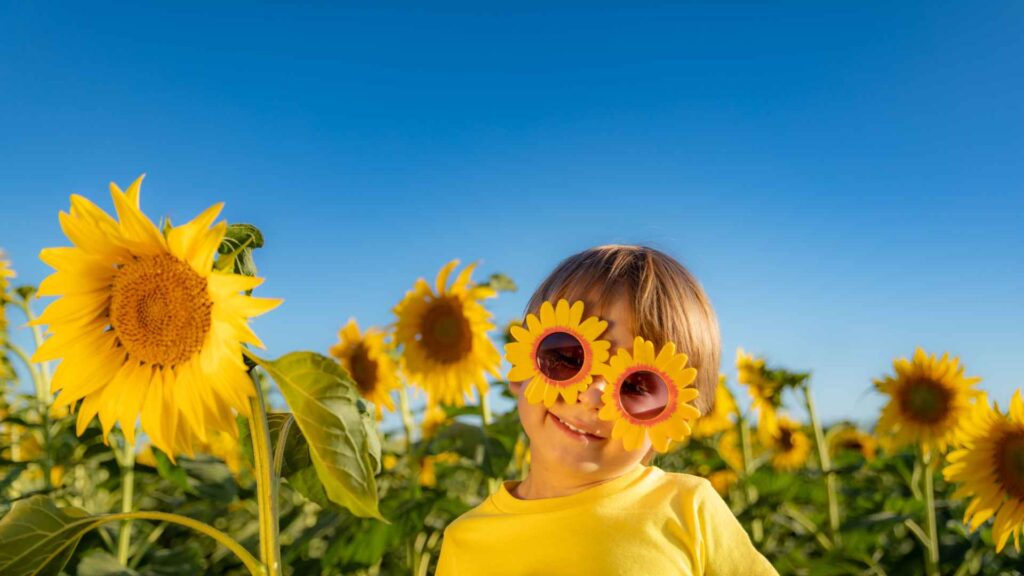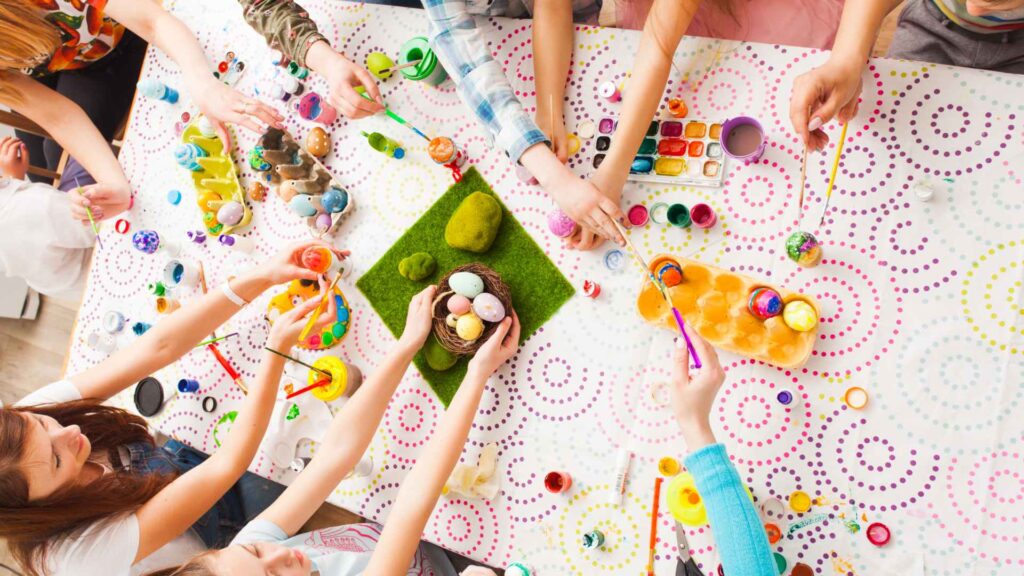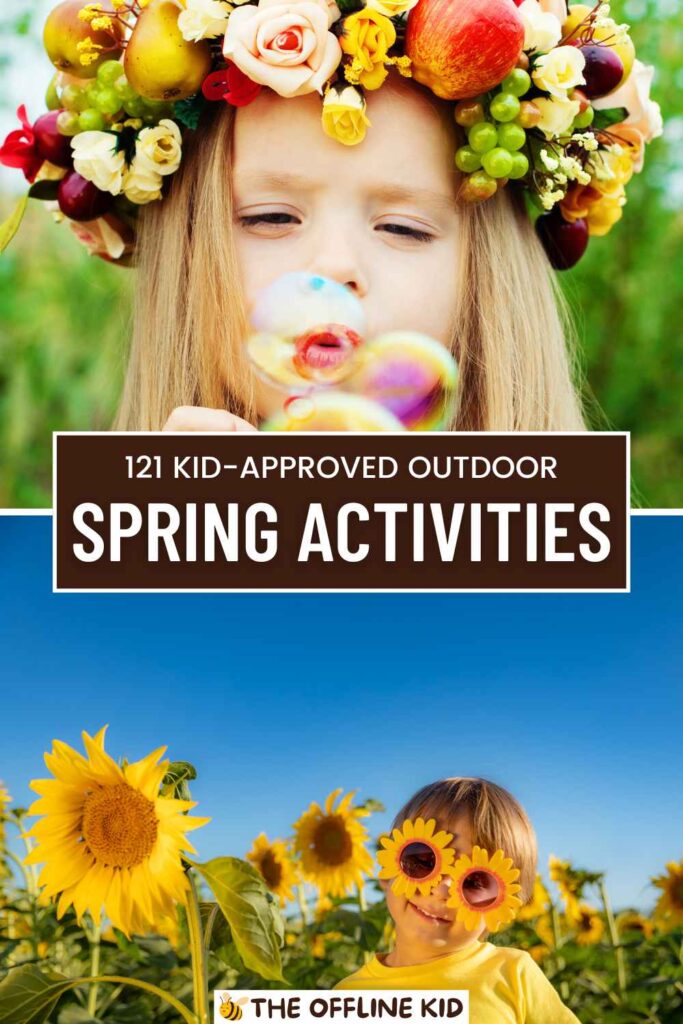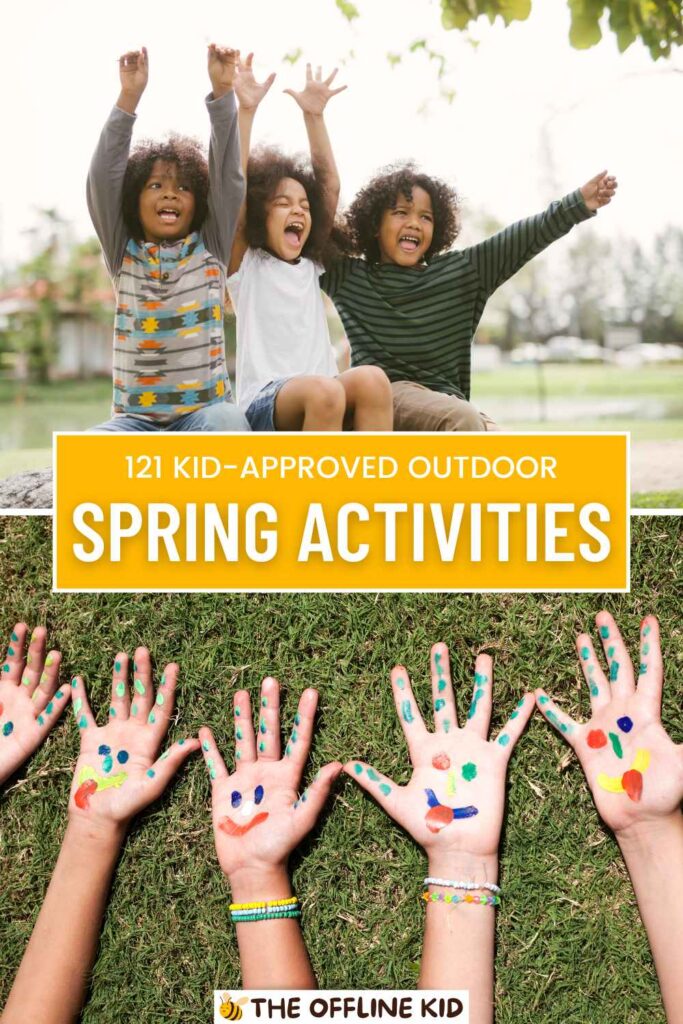Spring is the perfect time for kids to explore the great outdoors.
From creative crafts to adventurous games, this guide offers 121 fun and engaging activities that will keep your kids entertained and active all season long.
Creative Activities
Nature Art
- Leaf Rubbings: Collect various leaves, place them under a sheet of paper, and use crayons to rub over the paper, revealing beautiful leaf patterns.
- Rock Painting: Gather smooth rocks and paint them with colorful designs, patterns, or even positive messages to spread around the neighborhood.
- Creating Nature Collages: Use collected leaves, flowers, twigs, and other natural materials to create beautiful collages on cardboard or paper.
Crafting with Natural Materials
- Pinecone Bird Feeders: Spread peanut butter on pinecones, roll them in birdseed, and hang them outside to attract and feed local birds.
- Flower Crowns: Gather wildflowers and create lovely flower crowns by twisting the stems together, perfect for imaginative play or a springtime photo shoot.
- Stick Sculptures: Use twigs and sticks to build small sculptures or even fairy houses, encouraging creativity and fine motor skills.
Outdoor Storytelling
- Setting Up a Storytelling Circle: Arrange a circle of logs or stones to create a cozy spot for sharing stories. Take turns telling tales inspired by nature.
- Creating Story Sticks: Find sticks and attach small items like feathers, beads, or leaves to represent different parts of a story. Use the stick as a prop while narrating.
- Using Nature Elements in Stories: Incorporate elements found during nature walks—like a unique rock or an interesting leaf—into imaginative stories.
Flower Pressing
- Collecting Flowers: Pick a variety of flowers from your garden or while on a nature walk.
- Pressing Flowers: Place the flowers between sheets of parchment paper and press them using heavy books or a flower press.
- Creating Art with Pressed Flowers: Use the pressed flowers to make greeting cards, bookmarks, or framed art pieces.
Mud Painting
- Making Mud Paint: Mix dirt with water to create different shades of mud paint.
- Creating Art: Use brushes or fingers to paint on rocks, tree trunks, or paper with the mud, adding natural elements like leaves and sticks for texture.
By engaging in these creative activities, kids can connect with nature while expressing their artistic side, making springtime even more enjoyable and memorable.

Active Games
Classic Outdoor Games
- Tag Variations: Play different versions of tag, such as freeze tag (where tagged players freeze until another player unfreezes them) or shadow tag (where players must tag shadows instead of bodies).
- Hide and Seek: A timeless favorite, hide and seek can be played in various outdoor settings, adding excitement and encouraging exploration.
- Red Rover: Form two lines and call players from the opposing line to run and break through the linked arms of your team. This game promotes teamwork and physical activity.
Sports and Physical Activities
- Backyard Soccer: Set up makeshift goals using cones or markers and enjoy a friendly game of soccer. This helps kids develop coordination and teamwork skills.
- Frisbee: Tossing a frisbee around is a simple yet engaging activity. Try games like ultimate frisbee or frisbee golf for added fun.
- Obstacle Courses: Create an obstacle course using household items and natural elements like logs or rocks. Encourage kids to navigate through it, promoting agility and problem-solving skills.
Fitness Challenges
- Mini Marathons: Organize a short-distance race in your yard or a nearby park. Use markers to define the start and finish lines, and cheer on the participants.
- Relay Races: Set up relay races with various tasks, such as sack races, egg-and-spoon races, or three-legged races. These activities foster cooperation and a sense of achievement.
- Yoga in the Park: Introduce kids to basic yoga poses in a tranquil outdoor setting. Yoga enhances flexibility, balance, and mindfulness, making it a perfect springtime activity.
Jump Rope Games
- Single Jump Rope: Teach kids traditional jump rope rhymes and games, encouraging them to jump in time with the rhythm.
- Double Dutch: If you have more than one jump rope, try double Dutch. This challenging game involves two ropes being turned in opposite directions.
- Jump Rope Challenges: Set goals for how many jumps can be completed in a minute or who can perform the most tricks.
Ball Games
- Catch and Throw: Simple games of catch with a softball or tennis ball help improve hand-eye coordination.
- Kickball: A mix of soccer and baseball, kickball is a fun game that involves kicking a ball and running bases.
- Four Square: Use chalk to draw a four-square court on pavement, and teach kids the rules of this classic playground game.
Hula Hooping
- Basic Hooping: Teach kids how to keep a hula hoop spinning around their waist.
- Hula Hoop Contests: See who can keep their hula hoop going the longest or perform the most tricks.
- Hula Hoop Games: Incorporate hula hoops into obstacle courses or use them as targets for throwing games.
Engaging in these active games not only keeps kids physically fit but also helps them develop social skills, coordination, and a love for outdoor play.
Nature Exploration
Nature Walks and Hikes
- Identifying Plants and Animals: Equip kids with a field guide or an app to identify various plants, trees, and animals during walks. Encourage them to keep a nature journal to document their findings.
- Scavenger Hunts: Create a list of items to find, such as specific leaves, rocks, or insects. This turns a simple walk into an exciting adventure.
- Nature Photography: Give kids a camera or smartphone to capture interesting sights. Focus on themes like textures, colors, or wildlife, fostering an appreciation for nature’s beauty.
Gardening
- Planting a Vegetable Garden: Teach kids how to plant and care for vegetables. Let them choose their favorite veggies, and involve them in watering, weeding, and harvesting.
- Creating a Butterfly Garden: Plant flowers and shrubs that attract butterflies. Discuss the lifecycle of butterflies and observe their visits to the garden.
- Herb Gardening: Start a small herb garden with easy-to-grow herbs like basil, mint, and parsley. Explain their uses in cooking and encourage kids to taste and smell the different herbs.
Wildlife Watching
- Birdwatching: Provide binoculars and a bird guide to help kids identify different bird species. Set up a bird feeder to attract birds to your yard for easier observation.
- Bug Safaris: Arm kids with magnifying glasses and bug containers to explore the insect world. Teach them about different types of insects and their roles in the ecosystem.
- Pond Dipping: Visit a pond with a net and container to catch and observe small aquatic creatures like tadpoles, water beetles, and small fish. Always release them gently back into their habitat.
Tree Climbing
- Finding Climbable Trees: Locate safe, sturdy trees with low branches that are suitable for climbing.
- Safety Tips: Teach kids about tree-climbing safety, such as checking for strong branches and avoiding high climbs.
- Tree Exploration: Encourage imaginative play by pretending the tree is a fort, ship, or castle.
Nature Crafts
- Nature Bracelets: Wrap a strip of wide masking tape (sticky side out) around a wrist and attach small natural items like leaves, petals, and seeds to create a unique bracelet.
- Nature Weaving: Use a simple cardboard loom and weave in grass, leaves, and flowers to create beautiful nature-inspired textiles.
- Pressed Flower Art: Collect and press flowers, then use them to create cards, bookmarks, or framed artwork.
- Basic Astronomy: Teach kids about constellations, planets, and stars. Use a star chart or app to help identify them.
- Star Gazing Night: Plan an evening outdoors with blankets and a telescope or binoculars to observe the night sky.
- Making a Star Map: Help kids create their own star map by drawing constellations they see and learning their stories.
Building a Bug Hotel
- Collecting Materials: Gather twigs, leaves, bark, and other natural materials to create a bug-friendly habitat.
- Assembling the Hotel: Stack the materials in a sheltered spot, creating various layers and hiding places for insects.
- Observing Inhabitants: Regularly check the bug hotel to see what creatures have moved in and learn about their roles in the environment.
Exploring nature helps kids develop a deeper connection with the environment, fostering curiosity, respect, and a lifelong love for the outdoors.

Water Activities
Water Play
- Splash Pads and Sprinklers: Set up a sprinkler or visit a local splash pad where kids can run through the water and cool off on warm spring days.
- Water Balloon Fights: Fill balloons with water and organize a playful water balloon fight. Set boundaries and rules to ensure safe and fair play.
- DIY Water Slide: Use a plastic tarp, add water and a bit of baby soap to create a slippery surface, and enjoy a homemade water slide in your yard.
Pond and Stream Exploration
- Catch and Release Fishing: Teach kids the basics of fishing, using simple gear to catch small fish in a pond or stream. Emphasize the importance of releasing the fish back into the water.
- Stream Stomping: Find a shallow stream where kids can wade, splash, and explore. Encourage them to look for interesting rocks, shells, and small creatures.
- Building Dams: Gather rocks, sticks, and mud to build small dams in a stream. Discuss the flow of water and how dams work, encouraging problem-solving and teamwork.
Beach Fun
- Sandcastle Building: Bring along buckets, shovels, and molds to build elaborate sandcastles. Enhance creativity by adding seashells, driftwood, and other beach finds.
- Beach Games: Play classic beach games like beach volleyball, paddleball, or beach Frisbee. These activities promote physical fitness and teamwork.
- Collecting Seashells: Walk along the shore to collect different types of seashells. Discuss the various creatures that once lived in them and use the shells for crafts or displays.
Puddle Jumping
- Rainy Day Fun: On a rainy spring day, dress kids in waterproof gear and let them jump in puddles. This simple activity brings joy and helps release energy.
- Puddle Art: After the rain, use the puddles as canvases. Kids can float leaves, petals, and small sticks to create ephemeral art pieces.
Boat Races
- Making Paper Boats: Teach kids how to fold paper boats and decorate them with markers and stickers.
- Racing the Boats: Find a shallow stream or pond and have races to see whose boat floats the fastest or travels the farthest.
- Natural Boats: Challenge kids to build boats from natural materials like sticks, leaves, and bark, and then test them in the water.
Water Science Experiments
- Sink or Float: Gather various objects and predict whether they will sink or float in water. Test the predictions and discuss why some objects float while others sink.
- Water Cycle in a Bag: Create a mini water cycle by placing water in a zip-lock bag, sealing it, and taping it to a sunny window. Observe the condensation and precipitation processes.
- Creating Rainbows: Use a hose to spray water into the air on a sunny day, creating rainbows. Explain how light refraction causes this beautiful phenomenon.
Duck Feeding
- Finding a Pond: Locate a local pond or lake with ducks.
- Feeding Safely: Bring duck-friendly foods like peas, corn, or oats (avoid bread). Teach kids how to feed ducks gently and from a distance.
- Observing Behavior: Watch the ducks’ interactions and behaviors, encouraging kids to take notes or draw what they see.
Water activities provide refreshing and exciting ways for kids to enjoy the outdoors, combining fun with learning opportunities about nature and science.

Educational Activities
Science Experiments
- Building a Weather Station: Create simple weather instruments like a rain gauge, barometer, and wind vane. Track daily weather patterns and compare them with official weather reports.
- Outdoor Chemistry Experiments: Conduct safe, fun experiments like baking soda and vinegar volcanoes, making slime, or creating rainbow bubbles. Discuss the chemical reactions taking place.
- Solar Oven Cooking: Construct a solar oven using a pizza box, aluminum foil, and plastic wrap. Cook simple treats like s’mores or nachos while learning about solar energy.
Environmental Stewardship
- Clean-Up Days: Organize a local park or beach clean-up. Equip kids with gloves and bags, and teach them about the importance of reducing litter and protecting wildlife.
- Recycling Projects: Create art or useful items from recycled materials. Examples include bottle cap mosaics, tin can planters, or plastic bottle bird feeders.
- Composting Lessons: Set up a compost bin and explain the process of composting. Let kids add food scraps and garden waste, teaching them about decomposition and soil health.
Learning through Play
- Nature-Based Math Games: Use natural items like sticks, rocks, and leaves to teach counting, addition, subtraction, and patterns. For example, create number lines with sticks or solve simple math problems using pebbles.
- Outdoor Spelling Bees: Organize a spelling bee outside. Use chalk to write words on the pavement, or spell out words with natural materials like sticks and stones.
- Historical Reenactments: Choose a historical event or period, and have kids dress up and act out scenes. This can be a fun way to learn about history while engaging in imaginative play.
Astronomy Nights
- Star Charts and Apps: Use star charts or astronomy apps to identify stars, constellations, and planets. Teach kids about the mythology and science behind the constellations.
- Telescope Viewing: If possible, use a telescope to get a closer look at celestial objects like the moon, planets, and distant stars.
- Creating Star Maps: Help kids draw their own star maps based on what they see in the night sky. Encourage them to learn and remember different constellations.
Botany and Plant Science
- Leaf Identification: Collect different leaves and identify them using a field guide or app. Discuss the different types of trees and their characteristics.
- Seed Dispersal Experiments: Study how different seeds travel by wind, water, or animals. Create simple experiments to see which methods work best.
- Growing Plants from Seeds: Plant seeds in small pots or garden beds and track their growth. Teach kids about the life cycle of plants and what they need to thrive.
Geology Exploration
- Rock Collecting: Go on a rock hunt and collect different types of rocks and minerals. Use a guide to identify and learn about their properties and formations.
- Fossil Hunting: Visit areas where fossils might be found. Teach kids how to look for fossils and what to do if they find one.
- Rock Art: Use collected rocks to create art projects, such as painting them or arranging them into patterns and designs.
Weather Observations
- Daily Weather Logs: Keep a daily log of weather conditions, including temperature, cloud cover, wind speed, and precipitation. Compare observations over time.
- Cloud Watching: Learn about different types of clouds and what they indicate about the weather. Spend time lying on the grass and identifying cloud shapes and types.
- Making Weather Instruments: Build simple weather instruments like anemometers, rain gauges, and thermometers to measure weather changes and patterns.
Animal Tracking
- Footprint Identification: Look for animal tracks in mud or snow and identify them using a field guide. Learn about the animals that made the tracks and their behaviors.
- Wildlife Cameras: Set up a wildlife camera in your yard or a local park to capture photos of nocturnal animals. Review the images and identify the animals seen.
- Nature Sketching: Bring a sketchbook and pencils on walks to draw animals observed in their natural habitats, encouraging detailed observation and artistic skills.
These educational activities blend fun and learning, helping kids develop a deeper understanding of the natural world while enjoying the great outdoors.
Adventure Activities
Treasure Hunts
- Geocaching: Use GPS devices or smartphones to find hidden geocaches in your area. Sign the logbook and trade trinkets, making it an exciting scavenger hunt.
- Map Reading and Orienteering: Teach kids how to read maps and use a compass. Set up an orienteering course in a park or wooded area, challenging them to find specific locations.
- DIY Treasure Maps: Create a treasure map with clues and hidden treasures around your yard or local park. Encourage kids to follow the map and solve puzzles to find the treasure.
Camping and Survival Skills
- Backyard Camping: Set up a tent in the backyard for a night of camping. Include activities like storytelling, star gazing, and making s’mores over a campfire or grill.
- Building Shelters: Teach kids how to build simple shelters using natural materials like branches, leaves, and tarps. Discuss the importance of shelter in survival situations.
- Learning to Use a Compass: Practice basic compass skills by setting up a course with different points to navigate. Explain how compasses work and their importance in navigation.
Exploring Parks and Trails
- Visiting State and National Parks: Plan day trips to local state or national parks. Explore hiking trails, visitor centers, and educational programs offered by park rangers.
- Biking Trails: Find family-friendly biking trails and spend a day cycling. Ensure everyone has the proper safety gear and knows the rules of the trail.
- Canoeing and Kayaking: Rent or borrow canoes or kayaks and explore local lakes or rivers. Teach kids basic paddling techniques and water safety.
Tree Climbing Adventures
- Finding Safe Trees: Identify sturdy trees with low branches suitable for climbing. Teach kids how to test branches for strength and the importance of climbing safely.
- Treehouse Building: If space and resources allow, build a simple treehouse or platform. Use this as a base for imaginative play and outdoor adventures.
- Tree Identification: Learn to identify different tree species by their leaves, bark, and shape. Create a checklist and see how many different types you can find.
Fishing Trips
- Basic Fishing Skills: Teach kids how to cast a line, bait a hook, and reel in a catch. Choose a local pond or lake where fishing is allowed.
- Catch and Release: Emphasize the importance of catching and releasing fish to maintain healthy fish populations. Show kids how to handle fish gently and release them safely.
- Fishing Games: Create friendly competitions to see who can catch the most fish, the biggest fish, or the most unique species.
Rock Climbing
- Bouldering: Find large boulders or climbing walls where kids can practice bouldering, climbing shorter routes without ropes.
- Climbing Gyms: Visit an indoor climbing gym to learn basic climbing skills and safety with experienced instructors.
- Outdoor Climbing: For more advanced climbers, plan trips to outdoor climbing locations with appropriate gear and supervision.
Exploring Caves
- Local Caves and Caverns: Research nearby caves that are safe and open for exploration. Take guided tours to learn about cave formations and wildlife.
- Cave Safety: Teach kids about cave safety, including the importance of staying with the group, using headlamps, and not touching delicate formations.
- Cave Mapping: Create simple maps of the cave or cavern to help kids understand its layout and navigate safely.
Wildlife Tracking
- Animal Tracks: Learn to identify animal tracks and follow them to see where they lead. Discuss the different animals that make the tracks and their behaviors.
- Bird Watching: Bring binoculars and a bird guide to identify different bird species. Create a bird-watching journal to record sightings and notes.
- Night Hikes: Plan a night hike to observe nocturnal animals. Use red-filtered flashlights to minimize disturbance and listen for nighttime sounds.
Exploring Waterfalls
- Local Waterfalls: Find local waterfalls to visit and explore. Teach kids about the formation of waterfalls and the ecosystems around them.
- Hiking to Waterfalls: Combine hiking with waterfall exploration. Plan routes that lead to or pass by waterfalls, making the hike more exciting.
- Waterfall Safety: Discuss the importance of staying on designated paths, not climbing on wet rocks, and respecting the power of the water.
Adventure activities provide thrilling and memorable experiences for kids, fostering a sense of exploration and discovery while teaching valuable skills and respect for nature.

Social Activities
Community Events
- Participating in Local Festivals: Check out local spring festivals, fairs, and events. Engage in activities like face painting, carnival games, and craft booths that promote community spirit.
- Outdoor Theater and Concerts: Attend outdoor theater performances or concerts. Bring a picnic blanket and enjoy live entertainment in a relaxed, open-air setting.
- Farmers Markets Visits: Explore local farmers markets to learn about fresh produce, local crafts, and artisanal products. Encourage kids to ask vendors questions and try new foods.
Group Games
- Capture the Flag: Organize a game of capture the flag with friends and family. Set clear boundaries and rules to ensure everyone has fun and stays safe.
- Tug of War: Use a sturdy rope for a classic game of tug of war. This activity promotes teamwork and physical strength.
- Kickball: Set up a kickball game in a yard or park. Explain the rules and encourage kids to work together to score runs and make outs.
Family Bonding Activities
- Picnic Outings: Plan a family picnic in a local park. Pack a variety of snacks and games, and enjoy a meal together in the fresh air.
- Family Bike Rides: Choose a scenic bike trail and go for a family ride. Make sure everyone wears helmets and follows safety guidelines.
- Evening Bonfires and S’mores: Set up a safe bonfire in the backyard or at a campsite. Roast marshmallows, make s’mores, and share stories or sing songs around the fire.
Neighborhood Games
- Street Hockey: Organize a friendly street hockey game with neighborhood kids. Use lightweight equipment and establish rules for safe play.
- Sidewalk Chalk Art: Spend time creating sidewalk chalk art with friends and neighbors. Draw murals, hopscotch grids, or play games like tic-tac-toe.
- Hopscotch and Jump Rope: Set up hopscotch grids or jump rope areas on driveways or sidewalks. These simple games provide hours of fun and physical activity.
Collaborative Art Projects
- Community Mural: Work together with neighbors to create a community mural on a large canvas or a designated wall. Each person can contribute their own artistic flair.
- Garden Projects: Start a community garden where families can plant and tend to different sections. This encourages teamwork and teaches kids about gardening and sustainability.
- Art Exhibitions: Organize a neighborhood art exhibition where kids can display their artwork. Set up a gallery in a garage or yard and invite everyone to appreciate the creative efforts.
Cultural Exchange Activities
- International Food Day: Host a potluck where each family brings a dish from a different country. This introduces kids to diverse cuisines and cultures.
- Storytelling Circles: Gather for storytelling sessions where each family shares a favorite story or folktale from their culture.
- Cultural Craft Workshops: Organize workshops to teach traditional crafts from various cultures, such as origami, beadwork, or weaving.
Volunteer Opportunities
- Community Clean-Up: Join or organize a community clean-up day to pick up litter in parks, playgrounds, or along trails. This teaches kids the importance of caring for their environment.
- Helping Neighbors: Encourage kids to help neighbors with tasks like gardening, walking pets, or carrying groceries. This fosters a sense of community and responsibility.
- Food Drives and Donations: Participate in food drives or gather items for donation to local shelters. Involve kids in collecting and sorting items, emphasizing the importance of helping those in need.
Game Nights
- Outdoor Board Games: Set up tables outside for board games like checkers, chess, or Jenga. This creates a fun, relaxed atmosphere for socializing.
- Card Game Tournaments: Organize a card game tournament with family and friends. Games like Uno, Go Fish, or Crazy Eights are easy to learn and play.
- Lawn Games: Play lawn games like bocce ball, cornhole, or croquet. These games are great for all ages and encourage friendly competition.
Social activities help kids build relationships, develop communication skills, and create lasting memories with family and friends while enjoying the beauty of the outdoors.
Relaxing Activities
Quiet Time in Nature
- Cloud Watching: Lie on a blanket and gaze up at the sky, identifying different cloud shapes and letting your imagination run wild. This simple activity is both relaxing and creatively stimulating.
- Reading Under a Tree: Bring a favorite book or a stack of picture books and find a cozy spot under a tree. The natural shade and fresh air make for a perfect reading environment.
- Outdoor Journaling: Encourage kids to keep a nature journal, documenting their observations, thoughts, and drawings about the natural world around them.
Meditative Practices
- Outdoor Yoga: Introduce kids to basic yoga poses in a peaceful outdoor setting. Focus on poses that promote relaxation, balance, and flexibility.
- Tai Chi: Practice simple Tai Chi movements that promote relaxation and mindfulness. This gentle exercise can be done in the backyard or at a local park.
- Nature Meditation Walks: Take slow, mindful walks in nature, encouraging kids to notice the sights, sounds, and smells around them. This practice helps cultivate awareness and presence.
DIY Outdoor Projects
- Building Birdhouses: Create birdhouses using wood or recycled materials. Decorate them and hang them in the yard to attract birds, fostering a connection with wildlife.
- Creating a Fairy Garden: Use small plants, pebbles, and miniature decorations to build a whimsical fairy garden. This activity encourages creativity and imaginative play.
- Making Wind Chimes: Collect natural items like shells, sticks, and pinecones, and string them together to create wind chimes. Hang them outside and enjoy the soothing sounds they produce.
Nature Crafts
- Pressed Flower Art: Collect flowers and leaves, press them in books, and use them to create beautiful art pieces like bookmarks, cards, or framed art.
- Nature Bracelets: Wrap a strip of wide tape (sticky side out) around the wrist and attach small natural items like leaves, petals, and seeds to create a unique bracelet.
- Nature Weaving: Use a simple cardboard loom and weave in grass, leaves, and flowers to create beautiful nature-inspired textiles.
Stargazing
- Basic Astronomy: Teach kids about constellations, planets, and stars. Use a star chart or app to help identify them and learn the stories behind constellations.
- Star Gazing Night: Plan an evening outdoors with blankets and a telescope or binoculars to observe the night sky. Bring along snacks and hot cocoa for a cozy experience.
- Making a Star Map: Help kids create their own star map by drawing constellations they see and learning their names and stories.
Bird Watching
- Setting Up Feeders: Install bird feeders in the yard and fill them with seeds to attract various bird species. Provide binoculars and a bird guide for identification.
- Keeping a Bird Journal: Encourage kids to document the birds they see, noting their behaviors and characteristics. This activity enhances observational skills and appreciation for wildlife.
- Building a Bird Bath: Create a simple bird bath using a shallow dish or bowl, and place it in the yard to attract birds. Teach kids about the importance of providing water for wildlife.
Gardening
- Planting Flowers: Choose easy-to-grow flowers and plant them in the garden or in pots. Teach kids about the basics of gardening and plant care.
- Herb Gardening: Start a small herb garden with herbs like basil, mint, and parsley. Discuss their uses in cooking and encourage kids to taste and smell the different herbs.
- Creating a Butterfly Garden: Plant flowers and shrubs that attract butterflies. Observe the butterflies that visit and discuss their life cycle and behaviors.
Picnic Relaxation
- Simple Picnics: Plan a simple picnic with favorite snacks and a blanket. Find a scenic spot in a park or garden and enjoy the tranquility of nature.
- Storytime Picnics: Combine a picnic with storytime, bringing along a selection of books to read aloud while enjoying the outdoors.
- Sketching and Drawing: Bring sketchbooks and pencils to a picnic and encourage kids to draw what they see around them, enhancing their observation and artistic skills.
These relaxing activities provide a perfect balance to more energetic pursuits, helping kids unwind, reflect, and connect with nature in a calm and mindful way.
Conclusion
Spring is a magical time for children to engage with the outdoors, fostering both physical activity and a deep appreciation for nature.
The 121 outdoor activities detailed in this guide offer a diverse array of experiences that cater to every child’s interests, from creative arts and active games to nature exploration and adventure.
Encouraging kids to participate in these activities not only keeps them entertained but also helps develop essential skills such as teamwork, problem-solving, and creativity. Furthermore, these experiences create cherished memories and strengthen family and community bonds.
As you embark on these adventures with your children, remember to take advantage of the beautiful spring weather and explore the endless possibilities that nature provides.
Whether it’s a simple nature walk, a thrilling treasure hunt, or a relaxing picnic under the trees, every moment spent outdoors enriches their growth and happiness.


